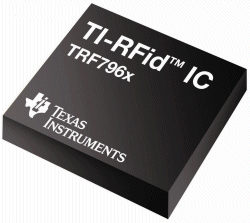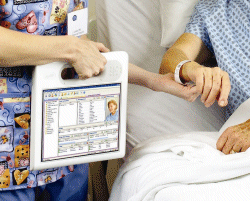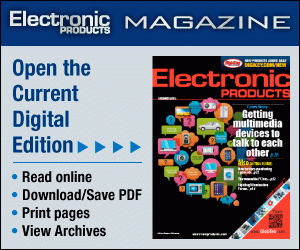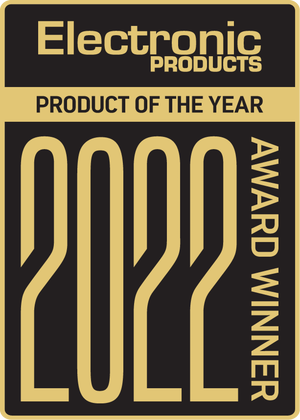Real or fake? New reader ICs answer the question
Addressing the limitation of earlier chips makes integrating RFID into devices for product authentication a viable option
BY SHREHARSHA RAO
Texas Instruments, Dallas, TX
http://www.ti.com
Radio frequency identification (RFID) has improved the security, efficiency, and reliability of hundreds of applications in a variety of industries since it hit the market a quarter century ago. With every passing year, the technology continues to evolve.
This improvement has created a new generation of reader ICs with innovative RF design approaches that are enabling a host of new RFID applications. One such area that’s poised to benefit greatly from the advancements in reader ICs is the product authentication market.

Fig. 1. The new generation of reader ICs provide innovative RF design approaches that are enabling a host of new RFID applications.
Until recently, authenticating high-value goods, pharmaceuticals, financial transactions, and medical devices using RFID technology proved difficult and financially unfeasible; previous reader ICs were large, costly, couldn’t address all protocols, and fell short of desired performance. These factors presented quite a few challenges for engineers looking to integrate the chips into their designs and supply chains. The next generation of reader ICs, which are on the market now, addresses the limitations of earlier chips and, in so doing, simplifies circuit design and makes integrating RFID into devices for product authentication a viable option.
Next-gen reader ICs
New reader ICs have fully integrated protocol handling and support multiple ISO standards including ISO / IEC 15693 and ISO / IEC 14443A/B, making them more flexible. And because they don’t require a second 13.56-MHz high-frequency (HF) chip to support these multiple ISO / IEC standards, as previous reader ICs required, they are more easily and inexpensively incorporated into devices for product authentication.
The chips are also significantly smaller than before, measuring just 5 x 5 mm (compared with previous chips that were 20 x 20 mm or larger). Prior versions of reader ICs used two 13.56-MHz crystals, one for the reader and one for the microcontroller, but new chips provide clock output to the microcontroller, removing the need for a second crystal.
Using just one crystal not only reduces the bill of materials (BOMs), but also the size of the module. The entire reader subsystem (IC, micro controller, and crystal) is smaller than previous reader ICs alone.
This difference in size is especially important when designing RFID into smaller products, such as an RFID-enabled blood glucose meter. The meter’s small size is an important selling point, and few companies would be willing to create a larger glucose meter just to accommodate an RFID function.
Despite the reduction in size, new reader ICs actually outperform previous chips; they provide greater read range, longer battery life, and fewer RF read holes. By integrating low-dropout regulators (LDOs) with high power-supply rejection ratios (PSRRs), the new ICs deliver increased read range for the same amount of power as current chips. Separate internal power supplies for analog, digital and power amplifier (PA) sections eliminate noise coupling and improve tag read reliability. And the adjustable voltage 20-mA LDO output for powering the external microcontroller eliminates the use of an external regulator, reducing module cost and minimizing board space.
The new chips’ dual input receivers ensure better coverage between RFID tags and readers by eliminating the read holes which occur when an RFID tag’s antenna changes the tag return signal from AM (amplitude modulation) to PM (phase modulation). The dual AM and PM receivers, coupled with the receive signal strength indictor (RSSI), ensures that the strongest signal is decoded. This translates into high reliability and makes the solution ideal for other product-authentication applications such as counterfeit prevention of luxury goods and pharmaceutical tracking from manufacturer to pharmacy, where read holes can occur due to variability in tag orientation with respect to the reader.
New reader ICs are also more power efficient and allow manufacturers to select power modes to maximize battery life. The chips contain seven user-selectable power modes, ranging from 120 mA in active and full-power mode (Pout = 200 mW) to less than 1 µA in complete power down, to maximize battery life.
In product authentication applications, the new reader ICs’ smaller size, ease of integration, improved durability, low-power use and cost effectiveness have made the most strides in realizing manufacturers’ return on investment. RFID also adds value to these applications because of its ability to read and write different algorithms, to uniquely identify the product and make the transmission more secure. While authentication as a whole stands to benefit greatly from new reader IC technology, currently four vertical markets in particular have the most potential: high-value goods, pharmaceutical, financial, and medical.
Counterfeit versions of high-value products such as designer handbags, jewelry, and cologne run rampant. If there’s any doubt, a quick walk down the streets of New York City will prove the point — you’ll find countless vendors selling an array of fake consumer products. And while in these instances most consumers know they’re buying a counterfeit good, many times this isn’t the case. And it’s often when consumers don’t realize they’re purchasing a counterfeit good that the most harm is done.
Although buying a fake brand name bag will not harm your health (just your wallet), buying counterfeit cologne can. For example, an international fragrance manufacturer discovered counterfeit perfume had entered its supply chain only after a woman who used the perfume called the company to complain about a rash she developed after using the phony fragrance. In addition to harming the consumer, manufacturers face the devaluation of their brand when lower-quality products carry their name, logo, and reputation.
With the higher cost of reader ICs in the past, it was difficult for manufacturers to justify integrating a few dollars for the reader IC into a $40 product, but with the reduced BOM of new tags, the investment is worth protecting the brand at both ends of the transaction. At the factory level, counterfeit goods will not leave the warehouse floor without being authenticated and at the customer end, buyers can be sure they’re paying a premium price for handbags handmade in Italy and nothing less.
In addition to high-value goods, the pharmaceutical industry is another market benefiting from next generation reader ICs. RFID technology offers external validation of a product’s authenticity and provenance. Determining if pharmaceutical products are genuine automatically and without human intervention is simply not economical without RFID. Products tracked with RFID raise the level of confidence that the product is genuine on two fronts: by determining the authenticity of the packaging, and by providing automated traceability to create an itemized record that an item has passed through authorized entities.
The financial sector is the third area that’s seeing great benefits from new reader ICs. Financial institutions have begun sending USB modules that have an integrated reader IC to account holders with their banking cards so when consumers make transactions during online banking sessions, the user can be confirmed as the correct account holder. This authentication is protecting consumers against identity theft, 80% of which occurs because computer key strokes cannot be encrypted, allowing thieves to more easily steal a user’s password.
Cost and size
Perhaps even more so than in the other three markets discussed, cost and size are two major factors when considering integrating RFID into medical products. With recent developments in reader IC technology, companies such as Austin-based Motion Computing are finding it feasible and beneficial to integrate RFID into medical products without sacrificing their size and drastically increasing the cost. Motion Computing recently integrated RFID into its Motion C5 mobile clinical assistant (see Fig. 2) , using Texas Instruments’ TRF7960 high-frequency, multi-standard RFID reader IC family. The chips’ small size and low power consumption helped to enable Motion Computing’s development of a thin, lightweight (about 3.3 lbs) portable computer that’s being used by physicians and nurses in hospitals around the U.S. to track and authenticate patients and their medical records. The device ensures that the right patient receives the right dose of medication at the right time.

Fig. 2. Recent developments in reader IC technology make it feasible and beneficial to integrate RFID into medical products without sacrificing their size.
Although the high-value goods, pharmaceutical, financial, and medical markets are only four of the many areas and applications new reader ICs are enabling, they are the ones the stand to benefit the most from the product’s flexible integration, smaller size, reduced bill of materials, greater read range, longer battery life, and fewer read holes. ■
Advertisement
Learn more about Texas Instruments





